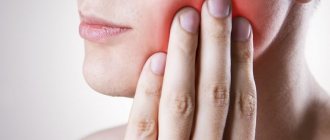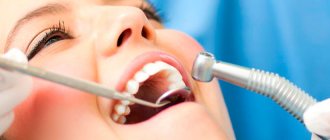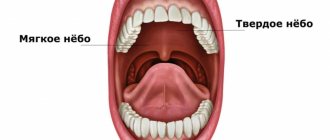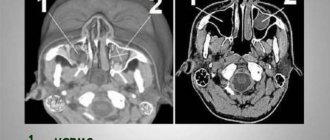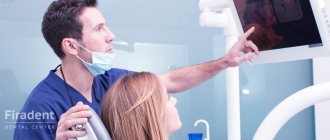30% of patients of ENT doctors come to clinics with complaints of diseases of the nose and paranasal sinuses. As a rule, these are sinusitis, sinusitis and other viral infections. Against the background of these diseases, inflammatory processes often develop in the paranasal sinuses. The main and unpleasant symptom of inflammation in the sinuses is pain.
Why do we have such a hard time with pain and inflammation in the sinuses? Is it possible to eliminate or reduce pain? To answer these questions, it is important to understand why we need the maxillary sinuses and why it is important to take care of their health.
How do the paranasal sinuses work?
The nose is one of the most important human organs. This system is complex and quite fragile, which leads to frequent illnesses. But without the maxillary sinuses, normal nose function would be impossible. They perform the following functions:
- provide full breathing;
- warm and humidify the inhaled air;
- clean the inhaled air from dust and allergens;
- allow you to recognize many aromas and smells;
- form an individual timbre and other voice parameters.
The sinuses have other tasks as well. For example, they quickly respond to changes in environmental pressure (act as baroreceptor organs) and reliably protect the eyeballs, tooth roots and skull bones from injury.
Why does inflammation of the sinuses develop?
Pain in the sinuses most often acts as one of the main symptoms of sinusitis or its varieties, for example, sinusitis, sinusitis and ethmoiditis. With sinusitis, the inflammatory process is localized in the paranasal sinuses of the upper respiratory tract, and with sinusitis, the maxillary sinuses become inflamed.
Why do the sinuses hurt with these diseases? These air cavities connect to the nasal cavity, which in turn is connected to the throat and ear canals. If a healthy person constantly produces mucus in the sinuses, which flows into the nose at a speed of 1 cm/min, then during the inflammatory process the following processes are observed:
- mucus production increases significantly and pus quickly forms in the sinuses;
- narrow passages for the outflow of mucus are completely blocked, it becomes difficult to breathe;
- fluid accumulates in the sinuses and presses on the walls - this is how a person begins to experience pain.
Which doctor should I contact?
Initially, if a sharp pain appears in the nose or ear, you can contact a therapist or otolaryngologist. If there is inflammation of the nerve, the patient may be referred to see a neurologist. Also, in case of injury, the help of a surgeon or traumatologist may be required.
When the presence of tumors in the nasal cavity or ear canal is detected, the person is sent to see an oncologist. After examination, in some cases he can confirm the benignity of the tumor, and if necessary, send the patient for tests, including a tissue biopsy of the tumor.
When a sharp pain in the ear appears, only a specialist can determine what to do. The same applies to problems in the nose area. Self-medication will easily lead to aggravation of the condition.
What are the causes of blocked sinuses?
There are usually several reasons:
- infections and viruses;
- polyps and tumors;
- allergies.
It has been proven that 90% of acute respiratory viral infections lead to the development of sinusitis of varying severity. And bacterial infections provoke sinusitis only in 0.5-2% of cases.
The sinuses most often hurt due to acute sinusitis, sinusitis, sinusitis or ethmoiditis. Symptoms of the disease appear as follows:
- Sinusitis. It will be “given away” by inflammation in one or more paranasal sinuses. When the inflammatory process occurs on one half of the face, we speak of hemisinusitis, when on both halves, we speak of pansinusitis. Acute sinusitis may include weakness, headache, fever, and changes in blood tests.
- Frontit. This is an inflammation of the frontal, or frontal, sinuses. With this disease, there is a characteristic increasing pain and pressure in the forehead, brow ridges and eyes. Other symptoms include general weakness, fever, and difficulty breathing.
- Ethmoiditis. It is an inflammation of the ethmoid labyrinth. The pain is localized in the center of the face. There is dark yellow-green nasal discharge, headache, high fever, swelling of the eyelids and fear of light, difficulty or complete absence of breathing.
- Sinusitis. The symptoms of sinusitis are difficult to recognize: the inflammatory process begins without fever. But with this disease there is a characteristic pain in the area of the face under the eyes. With sinusitis, there may be no nasal discharge, which also complicates diagnosis.
Causes of severe ear pain
Severe ear pain occurs most often due to damage to the middle ear. In such a situation, inflammatory processes or mechanical tissue damage may occur. It is also impossible to exclude the presence of acoustic trauma, when damage to the ear occurs due to a very loud sound.
Mechanical injuries include punctures of the eardrum, the entry of caustic chemicals into the ear, and the penetration of a foreign body into the ear. In this case, the pain is especially severe, accompanied by hearing impairment. Other causes of ear pain are:
- disturbance of intra-ear pressure due to a failure in the process of its regulation through the auditory tube - in such a situation, sharp pain appears at the moment of take-off due to the plane’s sharp climb to altitude and rapid pressure drop, as well as during a rapid dive to depth;
- excessive sensitivity of the ear to cold - in this case there are no pathological changes, but as soon as a person leaves the warmth for the cold, he develops a sharp pain in the ear. The exact reason for this phenomenon has not been established. Presumably it is associated with an excessive number of nerve endings in the tissues of the auditory canal;
- otitis – most often develops otitis media, in which inflammation affects the middle ear. In most cases, the problem is diagnosed in a child, but an adult can also encounter it. Otitis externa, in which inflammation affects the skin of the ear canal, appears much less frequently. The usual cause of external otitis is water entering the ear from an open, standing body of water, which contains a large number of pathogenic bacteria;
- mastoiditis - with this disease, inflammation affects the mastoid process of the temporal bone. More often, this phenomenon occurs as a complication of untreated acute otitis media;
- tumors in the ear;
- inflammatory diseases of the temporomandibular joint - the pain is very severe and appears at the slightest movement of the jaw. It is often mistaken for ear pain due to the proximity of the nerve endings, since the joint is located behind the front wall of the ear;
- dental diseases and incorrectly selected dentures - due to the fact that the same third branch of the trigeminal nerve is responsible for the sensitivity of the teeth and ears, it is not uncommon for pain to appear in the ear as a result of problems in the oral cavity. She can be very harsh and strong;
- the presence of tumors in the throat - quite often it is a sharp pain in the ear when swallowing that is the first symptom of the disease. At the same time, ear pathologies are not detected by examination, and therefore a mandatory examination is required to identify a hidden tumor process. A person may not feel other manifestations of the tumor;
- sinusitis - due to a rapid increase in pressure in the ear sinuses, sharp pain in the ears often appears when the body position changes. In such a situation, especially severe pain is observed in the ears during frontal sinuses, when inflammation affects the frontal sinuses.
Only a doctor can accurately determine the cause of ear pain. It is impossible to diagnose the problem on your own. Sharp pain in the ear, the cause of which has not been established, is an extremely serious signal and requires a full examination of the body.
How to treat sinus inflammation in adults and children?
Sinusitis, sinusitis and other inflammatory processes have similar symptoms. Treatment in adults will be effective if a specialist makes an accurate diagnosis and selects the optimal complex therapy, which will include:
- special medicines;
- healing procedures;
- prevention.
It is important not only to relieve the symptoms of the disease, but also to eliminate the causes of the disease. And they can be different. Some people have a weakened immune system, while others should have their body examined or give up bad habits and an unhealthy lifestyle.
In children, treatment of sinusitis, sinusitis and other inflammatory processes of the nasal sinuses also includes a whole range of measures:
- it is important to see a doctor quickly to make a diagnosis and avoid complications;
- you need to strictly adhere to the recommendations of specialists and monitor the child’s condition;
- It will be necessary to prevent inflammation in order to maintain the health of the child’s sinuses.
In the fight against serious inflammatory processes, one must not hesitate. For example, sinusitis can lead to inflammation in the skull or meninges. Acute catarrhal sinusitis develops in 70% of children who regularly suffer from ARVI. Odontogenic sinusitis develops in those who have dental problems.
How do you know if you have sinus inflammation?
With any inflammatory process, be it sinusitis, sinusitis, ethmoiditis or frontal sinusitis, you will notice 3 characteristic symptoms:
- Problems with nasal breathing – it will be difficult to breathe due to obstruction (blocking of the lumen) of the nasal openings due to swelling.
- Characteristic nasal discharge. They can be permanent or temporary. If there is swelling of the nasal mucosa, there may be no discharge.
- Headache and soft tissue swelling. During inflammatory processes, the face swells in the area of the frontal and maxillary sinuses. Sometimes the periosteum becomes inflamed (pereosteitis).
Publications in the media
Sinusitis is an inflammatory disease of the paranasal (paranasal) sinuses associated with infection or allergic reactions. Frequency : 10% of the population. Most often, the cells of the ethmoid bone are affected, then the maxillary, frontal and, finally, the sphenoid sinuses.
Classification of acute sinusitis • Acute sinusitis • Acute ethmoiditis • Acute frontal sinusitis • Acute sphenoiditis.
Classification of chronic sinusitis • Exudative sinusitis •• Purulent form •• Catarrhal form •• Serous form • Productive sinusitis •• Parietal-hyperplastic form •• Polypous form •• Cystic form • Cholesteatoma sinusitis • Necrotic sinusitis • Atrophic sinusitis • Mixed forms.
Etiology • Infection of the sinuses by various microflora •• Acute sinusitis is characterized by a monoculture: bacterial infection (pneumococci, streptococci, staphylococci; only in 13% of patients), viral infection (influenza virus, parainfluenza, adenoviruses) •• Chronic sinusitis is characterized by a mixed microflora: more often staphylococcus, Pseudomonas aeruginosa, Proteus, Escherichia coli, fungal infection (fungi of the genera Aspergillus, Penicillium, Candida) • Previous ARVI • Nasal tamponade with nosebleeds.
Risk factors • Complicated allergy history • Immunodeficiency conditions • Diseases of the dental system • Swimming in contaminated water.
Ways of infection to enter the nasal sinuses • Rhinogenic (through the natural anastomosis of the sinuses) • Hematogenous • Odontogenic • With sinus injuries.
Clinical picture
Acute sinusitis • General symptoms of acute sinusitis •• Nasal congestion •• Headache •• Fever •• Nasal discharge •• Cold symptoms • Acute sinusitis •• Nasal congestion •• Feeling of heaviness, tension in the cheek area, especially when bending the torso forward • • Feeling of pressure on the eyes •• Pain in the teeth on the affected side •• Headache of uncertain localization •• Nasal discharge of a mucopurulent or purulent nature •• Deterioration of smell •• Lacrimation (due to obstruction of the nasolacrimal duct) • Acute ethmoiditis. The symptoms differ little from acute sinusitis. Additionally, pain is noted in the root of the nose and orbit • Acute frontal sinusitis - headache in the forehead, especially intense in the morning (due to difficulty in outflow from the sinus when the patient is horizontal) • Acute sphenoiditis •• Headache in the back of the head, deep in the eye •• Drainage of purulent discharge from the nasopharynx along the back wall of the pharynx •• Unpleasant odor.
Chronic sinusitis • The clinical picture of chronic sinusitis without exacerbation is less pronounced than in acute sinusitis • Fungal sinusitis is characterized by: •• pronounced unilateral or bilateral nasal congestion; •• pain in the area of the affected sinus; •• pronounced feeling of pressure in the sinus; •• toothache (with sinusitis) • The nature of the discharge depends on the pathogen: •• with mold mycoses - viscous, grayish-white or dark, jelly-like; •• with aspergillosis - gray with blackish dots (reminiscent of cholesteatoma); •• with candidiasis - yellow or yellow-white color (resembles cheesy masses) • More often than with other forms, swelling of the soft tissues of the face, and sometimes fistulas, are observed. Usually they occur as monosinusitis, most often the maxillary sinus is affected.
Research methods.
• Rhinoscopy •• Acute sinusitis ••• Hyperemia of the nasal mucosa, most pronounced in the middle meatus. Purulent discharge drains from the middle turbinate ••• Palpation of the anterior wall of the maxillary sinus is painful •• Acute ethmoiditis. Purulent discharge is usually found in the middle and upper nasal passages (since all groups of cells of the ethmoid bone are affected). Painful palpation of the nasal slope area at the inner corner of the eye •• Acute frontal sinusitis - characterized by pronounced changes in the area of the anterior section of the middle turbinate. The mucous membrane in this area is hyperemic and edematous. Localization of accumulations of pus in the anterior sections of the middle nasal meatus. Painful palpation of the anterior and especially the lower walls of the sinus •• Acute sphenoiditis - with anterior rhinoscopy after anemization of the mucous membrane, a strip of pus is visible in the most posterior parts of the upper nasal passage. The posterior sections of the nasal cavity are hyperemic and edematous. Posterior rhinoscopy reveals accumulation of pus in the nasopharynx.
• X-ray of the sinuses - accumulation of fluid, fluid level, thickening of the mucous membrane in the affected sinuses.
• Diagnostic puncture - determining the presence of the nature of the discharge.
• CT scan in some unclear cases of chronic sinusitis.
Differential diagnosis • Viral rhinitis • Allergic rhinitis • Tumors • Foreign bodies • Wegener's granulomatosis.
TREATMENT
Acute sinusitis • For uncomplicated sinusitis, treatment is usually conservative •• Antibiotic therapy (for example, benzylpenicillin 500 thousand units 4-6 times / day) for 7-10 days •• Sulfonamide drugs (for example, sulfadimethoxine on the first day 2 g, then 1 g/day, co-trimoxazole 1 tablet 3 times a day after meals) •• Non-narcotic analgesics •• Vasoconstrictor nasal drops, for example 0.05–0.1% solutions of naphazoline or xylometazoline; instillation is carried out with the patient lying on his side. The vasoconstrictor effect gradually decreases, so after 5–7 days of use a break for several days is recommended. The drugs are contraindicated in arterial hypertension, tachycardia and severe atherosclerosis •• Physiotherapy (with good outflow from the sinus), for example, microwave therapy (LUCH-2 device), UHF currents, Sollux lamp •• On an outpatient basis for acute sinusitis, it is advisable to perform a sinus puncture with subsequent washing with nitrofural solution (1:5,000), iodinol, 0.9% sodium chloride solution and the introduction of antibacterial agents into it, for example benzylpenicillin (2 million units), 1% hydroxymethylquinoxylin dioxide solution (prescribed only to adults , before starting use, a tolerance test is carried out, contraindicated in pregnancy), 20% sulfacetamide solution •• In case of severe swelling, 1-2 ml of hydrocortisone suspension, 1% diphenhydramine solution are simultaneously injected into the sinus •• In acute frontal sinusitis, ethmoiditis or sphenoiditis and the absence of effect from conservative therapy, hospitalization is indicated for puncture or probing of these sinuses • For complicated acute sinusitis - surgical treatment •• Radical sinus surgery •• Endoscopic sinus surgery.
Chronic sinusitis
• In case of exacerbation - a combination of general and local treatment. Features •• For staphylococcal lesions, antibiotic therapy is not always effective. Anti-staphylococcal plasma is used (250 ml 2 times a week), staphylococcal g-globulin (1 ampoule every other day, 5 injections in total) •• For fungal sinusitis and without exacerbation - sulfonamide drugs, antifungal drugs, for example nystatin 3-4 million units/ day or levorin 2 million units/day for 4 weeks •• For allergic sinusitis - see Allergic rhinitis.
• Drainage of the maxillary sinus is performed using puncture - either a Kulikovsky needle is first inserted into a polyethylene tube, or after puncture a smaller tube is passed through the needle into the sinuses. Drainage is inserted into any sinus in a similar manner. To drain the frontal and sphenoid sinuses through natural openings, it is advisable to use a probe-conductor on which a tube is placed. After probing, the tube is left in place and the probe is removed. The outer end of the tube is attached to the skin with an adhesive plaster. Antibacterial agents are introduced into the sinuses through drainage, taking into account the sensitivity of the microflora to them •• To liquefy the pus, enzymes can be simultaneously introduced into the sinus (chymotrypsin 25 mg or chymopsin 25 mg) •• For allergic sinusitis, a suspension of hydrocortisone (2–3 ml) or antihistamines •• For fungal sinusitis, levorin sodium salt or nystatin is injected into the sinus at the rate of 10 thousand units per 1 ml of 0.9% sodium chloride solution, quinozole solution 1:1,000 or amphotericin B.
• Physiotherapy: microwaves, mud therapy (contraindicated in case of exacerbation of sinusitis). Physiotherapy is contraindicated for hyperplastic, polyposis and cystic sinusitis.
• Surgical treatment - for polypous, mixed forms, as well as in case of ineffectiveness of conservative treatment of exudative forms •• Radical operations on the sinuses for the purpose of their sanitization by applying an artificial anastomosis with the nasal passage (for sinusitis - methods according to Caldwell-Luc, Dliker-Ivanov, with frontitis - according to Killian) •• Osteoplasty with a closed method (Mishenkin N.V., 1997) •• Ultrasound surgery.
Complications • Orbital (orbital) •• Cellulitis •• Optic neuritis (rare) •• Orbital periostitis •• Edema, abscess of retrobulbar tissue • Panophthalmos (inflammation of all tissues and membranes of the eye) - very rare • Intracranial •• Meningitis •• Arachnoiditis • • Extra- and subdural abscesses •• Brain abscess •• Thrombophlebitis of the cavernous sinus •• Thrombophlebitis of the superior longitudinal sinus •• Septic cavernous thrombosis.
Concomitant pathology • Rhinitis • Barosinusitis • Pansinusitis.
Prognosis: for acute sinusitis, favorable with timely treatment and prevention of complications; for chronic sinusitis, it can be favorable if the allergen is eliminated and good drainage is ensured.
Age characteristics • Children and adolescents •• The incidence of acute and chronic sinusitis increases in late childhood •• An increase in incidence is observed among children with tonsillitis and adenoids •• The presence of chronic sinusitis indicates the need to determine the cause underlying the disease (nasal deformity, infection, adenoids) • Elderly •• Incidence increases by age 75, then decreases •• Sinusitis is more difficult to cure in this age group.
ICD-10 • J01 Acute sinusitis • J32 Chronic sinusitis
How to cure sinusitis, sinusitis and other inflammations?
What you definitely shouldn’t do is diagnose yourself and buy medications without a prescription or doctor’s recommendations. If sinusitis is mild, then the body will quickly cope with the source of the problem and defeat the infection or virus. But if sinusitis has become chronic, special therapy is needed:
- medicines that clear the air passages;
- antibacterial drugs to eliminate infection;
- rinsing the sinuses with antibiotics;
- surgical intervention in selected cases;
- regular preventive measures.
Of course, it is better to prevent sinusitis from becoming severe. Indeed, in this case, surgical intervention cannot be avoided. Why is this scary?? Just look at the image below, the hand-drawn picture of surgical techniques will give you a chill between your shoulder blades!
Causes of nose pain
Pain in the nose appears much less frequently than in the ear, but can also occur suddenly, without reasons clear to the patient. It is possible to understand what caused the sharp pain without consulting a doctor only in case of injury. The moment of its receipt is obvious, and tissue damage can sometimes be determined even by eye. Most often, soft tissue or nasal cartilage are injured. To exclude a fracture of the skull bones, an x-ray is required. If the damage has affected the cartilage, it is mandatory to seek medical help.
Other reasons why sharp pain in the nose appears may be:
- the beginning of the development of a boil - pain occurs sharply at the moment of development of the infiltrate and quickly increases. This may cause the nose to become swollen and red. The general condition of the patient suffers quite often due to the appearance of intoxication;
- acute inflammation of the paranasal sinuses or exacerbation of sinusitis in a chronic form - sharp pain in the nose is most often the first symptom of the disorder, which is quickly followed by other signs of the disease;
- Neuralgia of the nasociliary nerve - the problem in most cases appears before the age of 40 years. The pain is intense, paroxysmal, appearing very sharply. More often, an attack develops at night and lasts from half an hour to several hours;
- ganglionitis of the pterygoid ganglion - sharp, unexpected pain appears in the nose area and radiates to the orbit and directly to the eye. Much less often, in some cases, pain may also occur in the gums. The attack most often begins at night and lasts from several minutes to 2 days. Over-the-counter analgesics help little.
They can cause severe pain in the nose and tumors that disrupt the position of the nerve endings. In most cases, they are benign and can be easily removed. Malignant tumors of the nose require much more serious treatment, and in their advanced form the prognosis for the patient is not favorable.
Prevention is the best remedy for sinus inflammation
Of course, no one can be 100% insured against sinusitis and more severe inflammatory processes. Prevention will help strengthen the immune system and build a protective barrier against viruses, bacteria and infections. To prevent sinusitis without symptoms in an adult or child, you should follow simple rules:
- Avoid hypothermia. Yes, low temperature in itself does not provoke colds and runny nose. But it causes a narrowing of blood vessels and makes the mucous membranes more vulnerable to viruses and infections. In cold, rainy and windy weather, it is important to properly insulate - and you will not face chronic inflammation of the sinuses.
- Rinse your nose more often. This should be done in the fall during epidemics of colds and flu, as well as in the spring during the flowering of trees and shrubs. For rinsing, ordinary saline solutions are suitable, which effectively remove bacteria and allergens.
- Eat properly. The immune system weakens due to lack of nutrients. Include more natural products in your diet - fresh meat and fish, grains and slow carbohydrates, vegetables and fruits. It’s better to avoid processed foods and fast food, or at least reduce their consumption to a minimum.
- Drink vitamins. Nowadays there are many special vitamin complexes and supplements with herbal active ingredients. They work gently but effectively: the result is noticeable within 1-2 weeks. And most importantly, they are completely safe, non-addictive and have no side effects.
What can be included in therapy during treatment?
Don’t know how to treat maxillary sinusitis besides pills? You need herbal preparations. They are good both in the treatment of existing inflammatory processes and as a preventive measure. Their effectiveness is explained by the special composition of active components. As a rule, these are herbal extracts.
Each capsule of this product contains a whole set, including up to 10 or more medicinal plants. It is this composition that helps to quickly eliminate the causes of the disease - any viruses and bacteria in the body, and also helps to cure sinusitis or sinusitis at an early stage.
Just one capsule a day - and your sinuses breathe freely, and your health remains normal even during seasonal colds!
